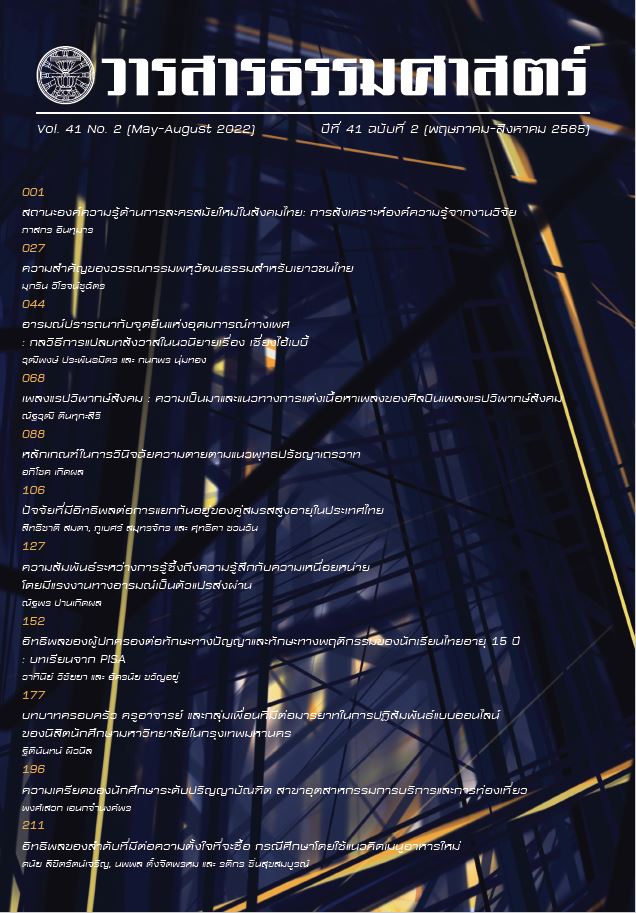Order Effect on the Intention to Purchase: The Case of New Food Concept
Main Article Content
Abstract
Consumer decision-making processes are not only based on rational decision but are often distorted by different psychological factors or biases. The influence of the order of perception of incoming information can have an effect on preferences, moods, and consumer decisions at that time. This phenomenon is known as the order effect. The aim of this study was to test the order effect of purchase intention using a new food menu concept as it is the type of item that consumers decide to buy based on their personal preference factor. The experimental study was conducted on 140 samples. The demographic factors including gender and age were used to divide the samples into two groups of equal size to reduce biases. In the experiment, both groups of food concept were presented in different orders and the techniques of two-way ANOVA was then used to examine the degree of purchase intention of such food as a dependent variable and two factors were food concepts and groups of participants whose order of obtaining food menu information was different. The results showed that food concept A earned a higher purchase intention level than food concept B, but there was a discrepancy between the two groups in purchase intention, indicating the order effect on purchase intention as the consumers are more likely to decide to purchase a food concept that has been presented first.
Article Details
References
Atkinson, R. C., & Shiffrin, R. M. (1968). Human memory: A proposed system and its control processes. In K. W. Spence & J. T. Spence, The psychology of learning and motivation: II. Academic Press.
Hogarth, R. & Einhorn, H. (1992). Order effects in belief updating: The belief-adjustment model. Cognitive Psychology, 24(1), 1-55. https://doi.org/10. 1016/0010-0285(92)90002-J
Li, C. (2010), Primacy effect or recency effect? A long-term memory test of Super Bowl commercials. Journal of Consumer Behaviour, 9, 32-44.
Monroe, Gary & Ng, Juliana. (1996). An Examination of Order Effects in Auditors' Inherent Risk Assessments. Accounting and Finance, 40, https://doi.org/ 10.1111/1467-629X.00041
Scarpi, D. (2004). Effects of presentation order on product evaluation: an empirical analysis. The International Review of Retail, Distribution and Consumer Research. 14. 309-319. https://doi.org/10.1080/09593960410001678408
Shan, L., Diao, H., & Wu L. (2020). Influence of the Framing Effect, Anchoring Effect, and Knowledge on Consumers’ Attitude and Purchase Intention of Organic Food. Frontiers in Psychology, 11, 2022. https://doi.org/10.3389/fpsyg.2020. 02022
Stewart, J., O’Shea, E., Donaldson, C., & Shackley, Phil. (2000). Do ordering effects matter in willingness-to-pay studies of health care? Journal of Health Economics, 21(4), 585-599. https://doi.org/10.1016/S0167-6296(02)00003-6
Suk, K., Jiheon, L. & Lichtenstein, D. (2012). The influence of price presentation order on consumer choice. Journal of Marketing Research, 49, 708-717. https://doi.org/10.1509/jmr.11.0309
Tversky, A., & Kahneman, D. (1974). Judgment under uncertainty: Heuristics and biases. Science, 185(4157), 1124–1131. https://doi.org/10.1126/science.185. 4157.1124
Tversky, A., & Kahneman, D. (1981). The framing of decisions and the psychology of choice. Behavioral Decision Making, 211(4481), 453–458. https://doi.org/ 10.1126/science.7455683
Von Neumann, J., & Morgenstern, O. (1944). Theory of games and economic behavior. Princeton University Press.
Wärneryd, K. (2008). The economic psychology of the stock market. In A. Lewis (Ed.), The Cambridge Handbook of Psychology and Economic Behaviour (Cambridge Handbooks in Psychology, pp. 39-63). Cambridge: Cambridge University Press.
Xu, Y. & Kim, H. (2008). Order Effect and Vendor Inspection in Online Comparison Shopping. Journal of Retailing, 84(4), 477-486. https://doi.org/10.1016/ j.jretai.2008.09.007.
